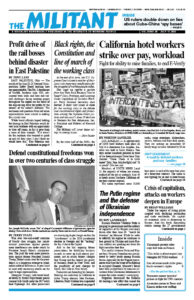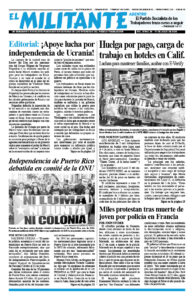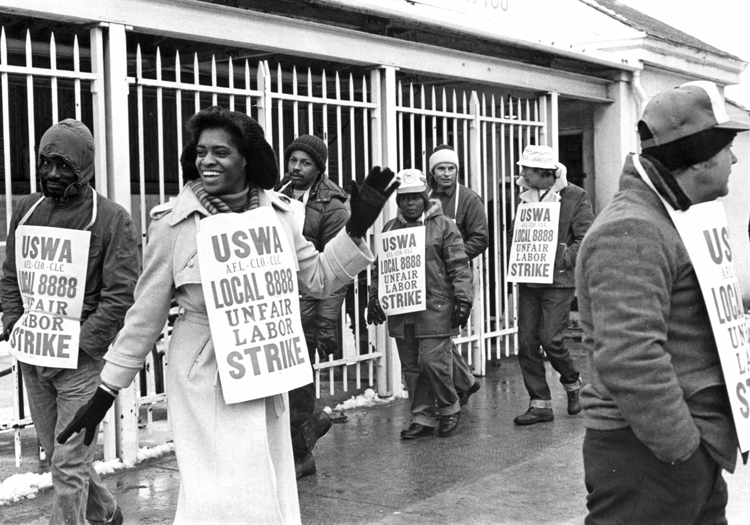At the end of its term, the U.S. Supreme Court issued a number of decisions with important ramifications for the struggles of working people today.
This week we reprint a section from Are They Rich Because They’re Smart? Class, Privilege, and Learning Under Capitalism by Socialist Workers Party National Secretary Jack Barnes. It deals with issues at stake for the working class in the debate over constitutional rights and protections among the Supreme Court justices and the court’s June 29 decision in Students for Fair Admission, Inc. v. President and Fellows of Harvard College.
The Militant will cover these rulings in coming issues.
— John Studer
By the latter half of the 1960s, the concept of equal justice under bourgeois law, fought for and more broadly codified through the mass civil rights struggles, had been extended to encompass explicit and transparent quotas in hiring, college admissions, and promotions — what came to be known as affirmative action. It helped break down barriers that had long blocked large numbers of African Americans from achieving such social status.
During those same years, the urban rebellions by proletarians who are Black in Harlem, Watts, Chicago, Newark, Detroit, and smaller cities all over the country — as well as the rise of Black nationalist consciousness and organizations — convinced the US rulers they had better concede something more than formal equality. At least for a time, they had to accept the need for quotas. The ground the working class had taken — including, in some cases, through our unions — was registered in victories such as the Weber decision in 1979.
Today the privileged middle-class layers the current president [Barack Obama] is part of are proud of being “color-blind” to a degree that is new to bourgeois society in the United States. The glue holding these layers together is not color but social class — or, to be more accurate, their entrenchment in a certain section of a social class. And it’s not uncommon for some of those who are Black, Latino, or female to note that, in their own individual cases, they got where they are — or could have — without any need for affirmative action.
Born as a victory of the working class and of the mass struggle for Black rights, affirmative action was initially a course of action aimed at unifying working people and the oppressed, in order to strengthen our unions and our struggles against the employing class and its government. In a few short years, however, it had been substantially corrupted into a tool of capitalist division benefiting the most privileged layers of Blacks, women, and other oppressed sections of the population — those seeking advancement into the meritocracy. Its corresponding political expression has been the attempt to suppress civil debate through wielding the “political correctness” club so hated by working people and others — a class reaction 2016 presidential contender Donald Trump has capitalized on.
A large section of the bourgeoisie today considers what they call affirmative action — which has little to do with its original social and class content — as necessary to the maintenance and reproduction of stable bourgeois social relations. The main function of such measures as they’ve come to be applied by the bourgeoisie is to reinforce illusions in imperialist democracy (i.e., “even a Black man can become president of the United States”). They are used to further divide African Americans and other nationally oppressed layers along class lines, and to deepen resentments and divisions within the working class as a whole.
At the same time, as both the labor movement and the struggle for Black rights receded, the rulers began taking back ground they had been forced to concede. The Supreme Court handed down decisions that increasingly restricted — in the words of a January 1989 decision — “the use of an unyielding racial quota.” Following another such Supreme Court ruling in 1995, the Clinton administration issued a memorandum calling for elimination of any program that creates “a quota,” “preferences for unqualified individuals,” or “reverse discrimination” — three longtime battle cries of opponents of hard-fought victories to strengthen working-class unity and solidarity, such as the Weber decision (see article).
A 2003 Supreme Court decision, while conceding the University of Michigan Law School could continue to take discretionary measures to maintain “a diverse student body,” ruled at the same time that “universities cannot establish quotas for members of certain racial or ethnic groups or put them on separate admissions tracks.”
Communists and other vanguard workers unconditionally oppose the rollback of any gains workers have registered that have reduced racist and antiwoman patterns of hiring, promotions, firings, and college admissions. At the same time, we give no political support to the way in which the bourgeoisie has more and more often implemented what they call affirmative action over the past two decades. If the class struggle does not advance, then gains such as the Weber decision are perverted over time by the very operations of capitalist social relations themselves, as they become programs that provide a golden key for some to enter an exclusive club further up the income rungs of US society.
Copyright © 2016 by Pathfinder Press. Reprinted by permission.


